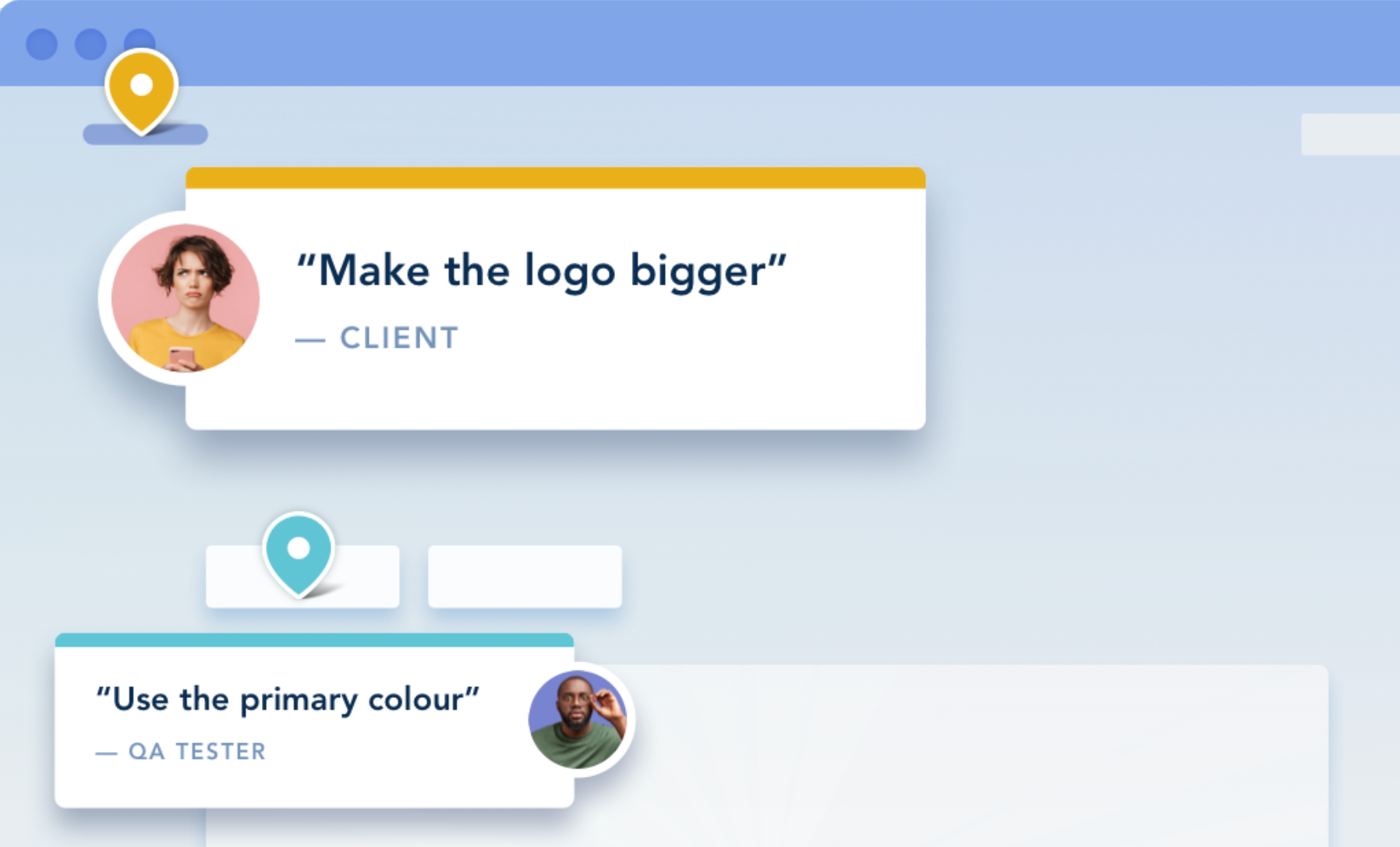This comprehensive step-by-step guide will dive deep into website project management, including methodologies and the role of tools in streamlining the feedback loop. We'll also highlight some common challenges and how to overcome them.
Picture this
You just received the brief: Create a clean, fully functioning, user-friendly website for the client's target audience. You, the project manager, assemble a team of designers and developers to make it happen.
You know the mission. The problem is you’re not sure where to start. All you know at this point is... there's lots to be done.
Having effective project management for website development is a great place to start. It involves meticulous planning to manage various aspects of website projects — from ideation to deployment.
Effective project management spells the difference between a solid digital shopfront for your client — delivered on time and within budget — and the website development team running like headless chickens trying to meet the launch date.
Without systematic project management, your dev team will likely commit errors, miss deadlines, encounter miscommunication, and go over budget.
Add to the mix the challenges of coordinating with siloed teams and getting feedback from non-tech-savvy clients who might struggle to articulate their vision or understand tech jargon. That image alone can make anyone run to the nearest door.
Understanding Website Project Management
Website project management brings the organized in "organized chaos.” It's a roadmap for website projects that defines the steps from design concept to website launch (and often, beyond launch).
It gets everyone in the website development team, including the client, on the same page regarding project milestones, timings, resources, budgets, and overall scope.
As the website project manager, your role is to wave the baton so the symphony creates beautiful music together. In dev terms, you must lead the team in making crucial decisions and ensuring that all boxes are ticked before you launch the website for public consumption.

Effective project managers possess not just leadership and technical know-how but also excellent communication, coordination, and problem-solving skills. They also ensure that everyone involved is clear on the following:
- Scope: What are the website project's goals and deliverables? What's the outcome that needs to be achieved? The team needs to define this at the onset to avoid "scope creep", or when the project exceeds the original set of deliverables.
- Timeline: Are there key milestones and internal deadlines? What's the go-live date? Effective project managers create detailed Gantt charts and ensure everyone sticks to the timing.
- Resources: What are the tools, software, materials, and human resources required to complete the project successfully?
- Budget: Estimate the website development costs and set guardrails to track and control them.
Challenges in Website Project Management
There's no better feeling than overseeing and finishing the website project as efficiently as possible. But it's not as simple as that. Project managing a website can be tricky because a curveball can hit you anytime. These curveballs come in the form of:
Scope Creep
When you see continuing changes or growth in the original scope without adjustment to budget or resources, you're experiencing scope creep.
You'll know the scope may be creeping when you hear words like “What if we tried this?” or “Can I see another version?”
You can avoid scope creep by having a formally approved and signed scope of work and fees at the start of the engagement. Work in phases and set specific milestones and key deliverables in your web design workflow.
And when scope creep is in front of you, you can manage client expectations by framing the conversation to focus on project goals, agreed scope, and even trade-offs ("Given the timeline of this project, what are the most important things to focus on and what needs to be parked?")
Missing Deadlines
“Underpromise, then overdeliver” should be your team's mantra.
Know and establish how long a particular task takes by consulting team members. Set conservative deadlines based on how long past and similar projects took or how efficient and available a team member is. Consulting them adds a layer of accountability and ownership.
However, setting deadlines is only one part of the equation. Meeting deadlines is the main crux of project management. How can you ensure each team member meets internal deadlines and completes a milestone on time?
Establish clear communication channels and regular check-ins to keep everyone informed and aligned. Overcommunicating in this context shouldn't be frowned upon; it can take you far in managing client expectations.
To keep everyone on the same page on how the project's tracking, use client collaboration tools like Asana and Notion.
Team Collaboration and Dynamics
So many elements around how the team works together can delay the project.
Are people in design, dev, and content talking to each other? Or is the project manager keeping them in the loop?
Does everyone work harmoniously with each other? Do they all understand each other, or are there non-techy folks who need help understanding tech jargon or articulating their ideas?
To ensure the answer to these questions is a resounding "yes", establish clear communication channels and set up regular check-ins. Tools also help show what each other is doing and how they're tracking. On-page and real-time collaboration is possible with tools that allow visual feedback like Bugherd.
Gathering and Managing Feedback
Gathering and managing web design feedback can be tricky, especially when managing multiple individuals.
The feedback loop can be longer because of back-and-forth, miscommunication, and disagreements. It can also be problematic for clients who don't understand tech jargon to articulate their thoughts and opinions (e.g., "I want the button to pop" without adding more details).
To avoid this situation, equip your team with the right tools to annotate, leave comments, and provide contextual feedback directly on the website. Tools with on-page and real-time collaboration features like Bugherd can help you streamline the process.
Project Management Methodologies for Website Development
There's an art to project management to ensure structure and transparency throughout the process. Some of the best practices in website development involve project management methodologies.
To find out which one best fits your project and workflow, we've listed here the key project management methodologies for website development, alongside their pros and cons:
Agile
If you see agencies and teams using the term "sprint", chances are they're using agile methodology.
This project management methodology focuses on breaking down the project into more manageable "cycles" or "sprints" with clear milestones or deliverables.
For web development projects, this could mean breaking down the workflow into discovery - wireframing and prototyping - designing - testing - deployment - maintenance and iterations.
"Perfect is the enemy of good" perfectly describes the agile methodology, as it focuses on delivering manageable chunks of work that can be iterated over time — instead of delivering the final product in one go.
Agile is the most commonly used methodology in the US, with over 70% of companies adopting it.
Pros: The main goal of Agile methodology is adaptability, collaboration, and continuous improvement. It's perfect for teams that need strong cross-functional collaboration, frequent changes, and quick responses.
Cons: Your team must be on the same page regarding each cycle or sprint. They should be clear on the milestones and timings behind them. Otherwise, scope creep and misaligned expectations are likely to happen. Also, because this methodology accommodates frequent changes, its main challenge is precisely that: frequent changes.
Kanban
If your team needs a visual way to track progress, then Kanban is the project management methodology for you.
It uses the Kanban board (Kanban is the Japanese word for signboard or billboard), where columns show the stage at which a card is. These columns may say "to start," "in progress," "for review," and "done." So at a glance, you'll see which tasks (in the card) are currently underway or completed. And you can also see how quickly a task moves from one column to another and those stuck.
Client collaboration tools like Trello and Asana have a Kanban board with cards that reflect more details about a task, including deadlines, who it's assigned to, comments, and file attachments. These are great tools to use during WIP meetings.
Pros: Kanban quickly shows the bottlenecks (when a card is stuck in a column for a long time), helping you manage workflows and improve processes. It's also highly visual so that you can see progress at a glance; few (if at all) details fall under the cracks.
Cons: This methodology may not work well if your project has multiple layers and dependencies, making it difficult to track individual progress under each task. Team members must also religiously update the board, which may not happen too often when it gets incredibly hectic.
Waterfall
Use the Waterfall methodology if you need a fixed and linear sequential approach to project management. It's perfect for projects that don't require changes throughout the workflow and where the team agrees to execute based on the original web development plan.
If something needs to change at any stage in the workflow, the team must start again. Because of this, the Waterfall methodology requires meticulous planning and an extremely clear brief from the client. Everyone has to execute and follow task details to the tee, including deadlines and assignees.
Tasks are laid out in a sequence. Team members can only start the next job when the current one is finished.
Pros: Waterfall is straightforward, so anyone can easily understand the plan. It's great for projects with fixed requirements and a clear vision of the outcome.
Cons: It needs to be more flexible. Any changes in scope or requirements will take the entire team back to the drawing board, derailing the schedule and budget.
Scrum
Scrum is similar to Agile in that it's also comprised of sprints. However, Scrum addresses backlogs in shorter sprints (2-4 weeks).
This is how it works: The leader, called the "Scrum Master," oversees the project — identifying the backlogged tasks and organizing a sprint to address one stuck task at a time. The team will go through everyday check-ins to let everyone know the following:
- Tasks done yesterday
- Today's tasks
- Any blockers
At the end of the day, the Scrum Master will track the progress in a "Retro Meeting" or "Sprint Review".
Scrum works if your project is highly complex and has a few backlogs. Also, if the team needs deep focus to complete a task and an optimized workflow can help get quick wins.
There should be daily team communication and ruthless prioritization for Scrum to work. The Scrum Master should also be firm and be able to spot bottlenecks to ensure daily progress.
Pros: Quick sprints bring quick wins. It helps the team focus on one crucial task at a time, which is helpful in complex projects.
Cons: Scrum requires a competent Scrum leader backed by experienced and self-organizing team members. If done haphazardly, Scrum might do more harm than good as it may lead to burnout.
Critical Path
Critical Path suits you best if you have a large and complex project. This methodology involves:
- Identifying the most critical tasks that impact the end date, and their dependencies
- Estimating how long each task will take
- Setting the longest sequence of interdependent tasks as the critical path
- Set a timeline around the critical path to finish it as soon as possible
Once the critical path is identified, all efforts and resources will be focused on finishing it. Doing this ensures that the most crucial parts of the project are done on time.
Pros: Critical path shows the sequence of the most essential tasks visually. Defining the critical path also ensures that crucial parts of the workflow get done and guides the team to allocate resources better.
Cons: Identifying and managing the critical path takes a lot of work, especially for large projects with many dependencies. Also, this methodology assumes that task durations are fixed and don't consider resource availability.
Steps for Effective Website Project Management
So far, we've talked a lot about project management, but we have yet to discuss what an effective one looks like. Here are a few steps to ensure your next website project is a raging success:
1. Define the Project Scope, Budget, and Timeline
Start with the fundamentals. Outline the scope and what it aims to achieve. Define the budget and set project estimates. Establish the timeline after consulting everyone from your team and the client.
And the most critical part: Ensure everyone involved — including the decision-makers — agree on those above. Get a signed version of the proposed scope of work and fees.
2. Identify the Project Management Methodology
Determine which project management methodology best suits your project's needs and team's working style. Get everyone on board and ensure the entire team knows what to do.
3. Plan and Create the Project Roadmap
Lay out the project's timeline, including key milestones and deliverables. You'll later thank yourself as you keep track of the project's progress.
4. Adopt a Web Design Project Management Tool
Tools like BugHerd, Trello, Asana, or Notion can streamline your project management process by providing features for task management, time tracking, collaboration, and reporting.
5. Optimize Resources from Start to Finish
Identify the resources you need and make the most of what you have. Assign tasks based on skills and availability, and use tools to streamline your workflow.
6. Simplify Collaboration Between Teams and Departments
Effective communication and collaboration can go a long way in successful website deployments. Use collaboration tools to facilitate discussions, share files, and provide updates.
7. Send Deliverables for Client Review and Implement Changes Received
Don't shy away from overcommunication. Regularly share deliverables with the client for review. This allows for early feedback and reduces the chances of significant revisions later. Implement any changes received promptly.
8. Launch the Project
After testing and final client approval, it's time to launch the website. Ensure all technical and functional aspects are working correctly and the site is optimized for search engines.
9. Close the Project
Review the project once the website is live to identify what went well and what could be improved. Celebrate your team's hard work and success!
The Role of Web Design Project Management Tools
You need project management tools if you want your team to go as efficiently as possible for a website project.
Web design project management tools can serve as your Swiss army knife in improving productivity, streamlining your workflow, enhancing communication, and facilitating an easy feedback loop. They help you plan more systematically and visually, allocate and manage resources, and manage time.
When looking for a project management tool, consider the following features:
- Task management to assign team members and set deadlines
- Collaboration tools like chat, file sharing, and comment sections
- On-page and real-time website feedback tools that allows you to leave comments and annotations
- Reporting and analytics to manage project performance
- Robust integration capabilities so you can add other tools and software you use
Some of the top project management tools for website projects include:
We have a comprehensive list of client collaboration tools that could also work for project management.
Where To From Here
Website project management is no walk in the park. It requires skills, discipline, and team collaboration to ensure smooth progress and successful website deployment.
With suitable project management methodologies and tools, and hopefully, some of the tips from this article, you and your team can knock it out of the park!


















But don't just take our word for it.
BugHerd is loved by 10,000+ companies,
350,000+ users across 172 countries.
4.8/5
4.7/5
4.5/5
5/5
8.7/10
Sam Duncan 📱📏 🌱
@SamWPaquet
"@bugherd where have you been all my life??
We just migrated our bug tracking over from Asana and have at least halved our software testing time🪳👏📈. "
Ashley Groenveld
Project Manager
“I use BugHerd all day every day. It has sped up our implementation tenfold.”
Sasha Shevelev
Webcoda Co-founder
"Before Bugherd, clients would try to send screenshots with scribbles we couldn't decipher or dozens of emails with issues we were often unable to recreate."
Mark B
Developer
“A no-brainer purchase for any agency or development team.”
Kate L
Director of Operations
"Vital tool for our digital marketing agency.”
Paul Tegall
Delivery Manager
"Loving BugHerd! It's making collecting feedback from non-tech users so much easier."
Daniel Billingham
Senior Product Designer
“The ideal feedback and collaboration tool that supports the needs of clients, designers, project managers, and developers.”
Chris S
CEO & Creative Director
“Our clients LOVE it”
Emily VonSydow
Web Development Director
“BugHerd probably saves us
at least 3-4hrs per week.”